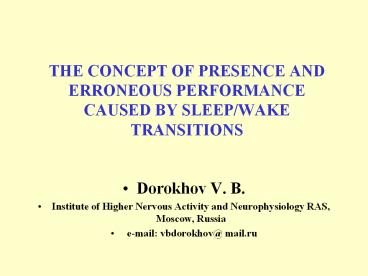THE CONCEPT OF PRESENCE AND ERRONEOUS PERFORMANCE CAUSED BY SLEEP/WAKE TRANSITIONS PowerPoint PPT Presentation
1 / 14
Title: THE CONCEPT OF PRESENCE AND ERRONEOUS PERFORMANCE CAUSED BY SLEEP/WAKE TRANSITIONS
1
THE CONCEPT OF PRESENCE AND ERRONEOUS
PERFORMANCECAUSED BY SLEEP/WAKE TRANSITIONS
- Dorokhov V. B.
- Institute of Higher Nervous Activity and
Neurophysiology RAS, Moscow, Russia - e-mail vbdorokhov_at_ mail.ru
2
Drowsiness
- Drowsiness is the cause of an accident on
transport and industry. - Drowsy subject is not to be aware the danger of
his own state. - Drowsiness is a change of a state of
consciousness at which the attention is switched
from external environment to internal information
processes that rather frequently is accompanied
by occurrence of hypnagogic images.
3
PresenceURL http//www.presence-connect.com
- Presence is defined as the subjective experience
of being in one place or environment, even when
one is physically situated in another
4
Evolution and presence
- Sense of presence allows the nervous system to
solve a key problem for its survival how to
differentiate between internal and external
states. ( Waterworth 2003). - Two kinds of information, the concrete and the
abstract. - Concrete information -via the perceptual-motor
systems from the world around us. - Abstract information must be realised mentally.
5
Internal mental world
- Sense of presence could appear in three cases in
a real world in a virtual world and in an
internal mental world (Int). - We do not always feel present in physical
environments. The daydreamer feels present
here in the mental imagery of the simulation
occurring in their head. This I have called the
reality problem, the need to explain how one
might not feel present even when exposed to high
fidelity sensory stimuli. (F. Biocca. 2002 )
6
Consciousness and presence/absence
- Presence is as attending to an external world -
real or virtual - Absence is as attending to a world that is
created internally . - ( Waterworth 2003).
- If we are lost in thought" we are not present
(in the real or a virtual world), but we are
conscious - To feel presence or absence both require
consciousness.
7
Measuring presence - Break In Presence (BIP)
- Presence is a product of an unconscious
continuous reality-check to fit what we perceive
with our senses (see, hear, touch, smell, taste).
The issues of presence is only interesting when
there are competing signals from at least two
environments. - Slater Steed (2000) propose a mechanism for
measuring presence, the Break In Presence (BIP).
Model, based on the idea that at any instant "t"
of time one either is present 100 or not, in one
environment, being this virtual or real. - This view is different to those of others that
actually proposes presence as a continuously
changing feeling with a shift of attentive
resources (Ijsselsteijn de Ridder, 1998). The
difference in view does not lie in the idea of
continuous against discrete ".. a break in
presence may be conceived of as an attentional
shift away from the mediated environment and
towards the physical environment, but with the
possibility to still feel a sense of presence in
the mediated environment, albeit to a lesser
extent." (Ijsselsteijn, 2002)
8
Two experimental models for investigation of
performance error during falling asleep
Driving simulator and polygraphic recording
- Psychomotorical test
- with the closed eyes in sitting or lying
position. - 1) counting of external stimulus (sound clicks).
- 2) self pacing counting without external
stimulation,
9
Electrodermal indices of the subjective
perception of performance errors
(BIP)?sychomotoric test, self-pacing button
pressing (right hand, sitting position)
- Skin conductance response (SCR), EEG, EOG, and
button pressings were recorded. - Error onset was shown to be preceded by the
decreased in the rate of spontaneous SCR.
Performance reappearance after the
self-detected error was accompanied by phasic SCR
and alpha-burst of EEG. - When participants spontaneously self-activated
and renewal of proper performance, he/she
reported about - "...lost in thought" Mean interval between the
error and the last preceding SCR 69.8 s Mean
interval between the error and the first
following SCR 10.1 s - . .
10
ALPHA-BURSTS AND K-COMPLEXACTIVATION PATTERN
AFTER ERRORS (BIP) ?sychomotoric test,
self-pacing button pressing (two hand, lying
position)
Theta error
Alpha activation
Performance reappearance KCalpha
11
ALPHA RHYTHM AND PERFORMANCE
Psychomotorical test (closed eyes, counting of
external stimulus - sound clicks). (two hand,
lying position)
Correct performance alpha rhythm
Performance error alpha blocking
Correct performance reappearance alpha
reappearance
12
Hypothesis EEG correlates of a
presence/absence switch is a alpha /theta
interaction
- It is known that during the transition from
waking to sleeping when the ability to respond to
external stimuli ceases, alpha power decreases,
whereas theta increases. It is suggested that
the encoding of new information is reflected by
theta oscillations in hippocampo-cortical
feedback loops, whereas search and retrieval
processes in semantic long-term memory are
reflected by alpha oscillations in
thalamo-cortical feedback loops . W. Klimesch.
1999
13
DREAMING and the BRAINToward a Cognitive
Neuroscience of Conscious States J. A. Hobson,
E. Pace-Schott, R. Stickgold (2000)
14
A State Space Model of the Brain-MindFrom J.
A. Hobson, E. Pace-Schott, R. Stickgold (2000)
DREAMING and the BRAINToward a Cognitive
Neuroscience of Conscious States
- A - (Activation)-??????? ????????? ?????. ???
????? ?????????? ????? ???? ?????????? ?????? - I - (Information flow)-?????? ????????
?????????? (??????? ??? ??? ????????? ?????).
????? ?????????? ?????????????? ?????? - M - Mode of information processing
- -????? ???????? ?????????? ??????????????
(???????? ??? ???????????????). ??? ???
?????????? ?????????????? ??????

